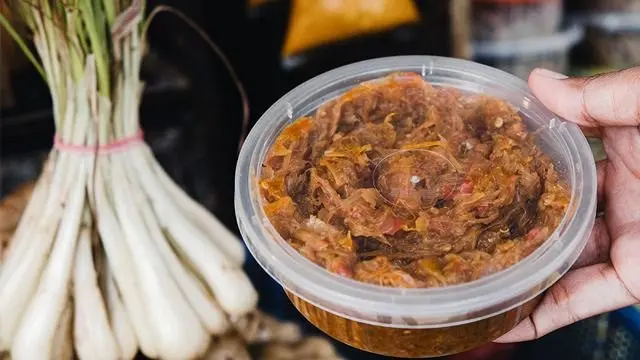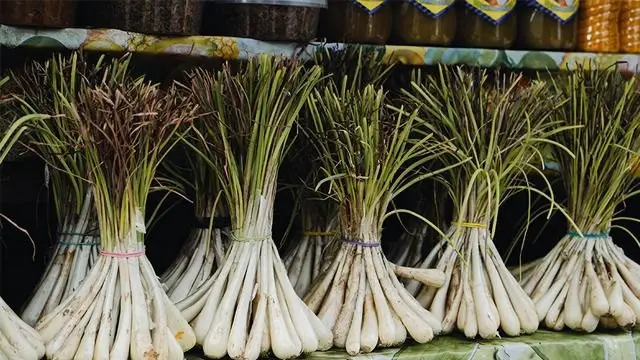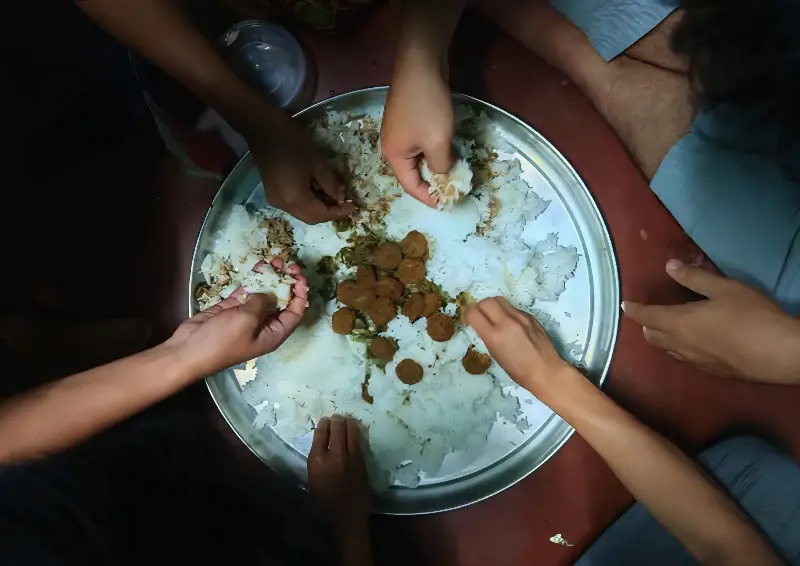
MARAWI, Philippines – In almost every Meranaw kitchen, the sharp scent of sakurab, the sizzle of chili, and the warmth of ginger fill the air. These are signs that palapa is being prepared. More than just a condiment, it is a staple that turns ordinary meals into something unmistakably Meranaw.
By simply adding palapa, a Filipino dish gains a spicy, savory flavor that has become a culinary signature in the Bangsamoro Autonomous Region in Muslim Mindanao (BARMM), especially in Meranaw culture.
Palapa is a traditional condiment used to enhance the flavor of various dishes. It is made from a crushed mix of sakurab (Lanao shallot), luya pagirisan (ginger) for aroma and flavor, and luya tidak (chili pepper) for its distinctive heat.

Its main ingredient, sakurab, is a type of shallot native to Lanao del Sur, making large-scale palapa production a challenge. Among Meranaws, sakurab and palapa are used interchangeably, indicating the cultural ties between the ingredient and the condiment.
In food preparation, palapa is remarkably versatile. It can be used as a flavor enhancer, an appetizer, or even a viand on its own during special occasions.
Take the well-loved chicken adobo, for example. In the Meranaw version, palapa is added to deepen its flavor. The same is true for grilled fish and other seafood dishes, provided they comply with halal standards.
Palapa has been passed down through generations, with each family developing its own recipe based on taste and tradition.
“In our family, we serve palapa in three main dishes such as chicken, meat, and fish. These recipes were passed down to my tita (aunt) from my lola (grandmother),” said Mindanao State University professor Najibullah Umpa.
He recalled his years as an elementary grader, when his aunt would prepare palapa for his mother and send some to his siblings studying at the University of the Philippines.
He said they always had a preserved version of palapa at home, noting that his aunt made it solely for the family.
“When we went to Hajj (Islamic pilgrimage), we brought palapa to help us adjust to the local food. Unfortunately, we only consumed half of it because palapa doesn’t contain natural preservatives,” Umpa shared.
Palapa has been reimagined in various food products, restaurants, and food festivals, but its unique spicy flavor remains unmistakable.
“Even an ordinary viand becomes special when you add palapa,” said Lanz Peredeon Lozaldo, a graduating student from MSU.
He shared that the spiciness of palapa often drives him to eat more. As an MSU student in Marawi City, he regularly buys palapa for its flavor and affordability. He once even brought it home to his province in Surigao del Sur.
Opportunity and innovation
In Lanao del Sur, palapa is everywhere. Each household has its own recipe and prepares it either as a daily condiment or viand.
Its ubiquity made it seem less viable as a business idea – at least at first. For years, its full potential remained largely within homes until some young Meranaws began turning it into a business venture. With its unique flavor profile, palapa has captivated both food lovers and entrepreneurs, gaining recognition locally and internationally.
“I asked my aunt why she didn’t venture into palapa as a business product. She told me, ‘Why should I sell palapa when everyone can make it as a household heritage?’” Umpa recalled.
He posed the question back in 6th grade, with no concept of business at the time. Today, he teaches business courses at MSU in Marawi City.
From a young age, Umpa was trained in entrepreneurship by his late father, Camar Umpa, who later became MSU president and founded Al Khwarizmi International College Foundation Incorporated.
Over time, Meranaws began to market palapa beyond their province. It is now available across the country, and many businesses have emerged around it. One such enterprise is Super Lumba, a startup run by young Meranaws that promotes palapa while creating livelihood opportunities for the community.
A Meranaw vlogger turned entrepreneur, Aisah Hadji Amer, also sells various traditional Meranaw dishes and delicacies online. She began vlogging in 2020 and launched her product line in 2024. Her signature “Taam-Taam” line features palapa preserved in oil.
She shared how her family once worked as farmers before she decided to start her own business. She recalled the struggles they faced just to make ends meet.
“My P1,000 capital became P10,000. I didn’t expect my ‘Taam-Taam’ products would trend online. From just 24 pieces, now I produce over 100 pieces and more,” Hadji Amer said in one of her vlogs.
Like Hadji Amer, many Meranaw entrepreneurs began their journeys with palapa. Another is Kakaw Meranaw, Lanao del Sur’s first chocolate producer. There have even been experimental attempts to create palapa-flavored ice cream, although these have yet to be officially launched.

History and culture
The Meranaws are the native inhabitants of the then undivided Lanao province, living around Lake Lanao, which is the country’s second-largest lake after Laguna de Bay. Because of this deep connection, they were called the “people of the lake.”
In 1959, the province was officially divided into Lanao del Norte and Lanao del Sur, recognizing distinct cultural, geographic, and administrative identities. From this division, Lanao del Sur emerged as the heartland of the Meranaws in the predominantly Muslim Mindanao region.
Over the decades, the Meranaws have gradually adapted to modern life. Their fashion has evolved, and they’ve adopted foreign languages and cuisines. Yet palapa has remained a steadfast cultural and culinary tradition, found in almost every Meranaw household.
Known for their love and tolerance of spicy food, the Meranaws express their courage and resilience through their cuisine, attributes reminiscent of the warrior spirit that once defended their land during colonial rule.
In Meranaw folklore, palapa is also believed to have spiritual properties. It is added to dishes served during wakes to ward off babal, supernatural beings similar to the aswang in Filipino mythology. Strong spices are said to repel these spirits, making them easier to detect during communal gatherings.
Traditional recipes
Palapa can be prepared and consumed in several ways. In Meranaw tradition, it is commonly used in three forms: as a fresh condiment, a preserved condiment, and a viand.
In small quantities, the three main ingredients are crushed and added directly to dishes during cooking or served raw as a side dish or appetizer, especially in the morning.
Take pater, for instance – a Meranaw dish made of sticky turmeric (yellow) rice and chicken cooked with shredded coconut (piyaparan a manok), wrapped in banana leaves. Unlike other paters, serving palapa on the side adds a distinct, savory dimension.
In larger quantities, palapa can be preserved for up to 20 days, depending on how it’s prepared. This version involves frying the mixture with salt, coconut oil, and additional seasonings to enhance flavor and extend shelf life.
This recipe is typically prepared for large gatherings such as pegang, kandori, and other communal events, especially during the holy month of Ramadan. It simplifies food preparation for Iftar, the meal to break the fast at sunset.
Palapa can also be served as a main dish. To prepare this version, grated and pulverized coconut is added to the cooked mixture and stirred until it turns brown. This variant is also mixed with boiled beef to make beef randing, or simply randing in Meranaw cuisine.
Some versions attempt to use sibuyas dahon (onion leaves) as a substitute for sakurab, though the taste differs. Ultimately, the secret lies in balancing the ingredients in the right proportions.
Palapa has become a source of pride and flavor for people from all walks of life. It has sparked growing interest in Meranaw spicy cuisine among individuals and communities far beyond Lanao del Sur.
From humble kitchens in Marawi and Lanao del Sur to online markets and food festivals, palapa continues to reach more people. Aside from being a flavor, it is a symbol of heritage, and a connection between past and present. For many Meranaws, palapa is a story that continues to be shared, one dish at a time. – Rappler.com
Abdul Hafiz Tacoranga Malawani is a campus journalist from Marawi City, Lanao del Sur studying Information Technology at Mindanao State University Marawi. He is the editor in chief of Mindanao Varsitarian and an Aries Rufo Journalism Fellow of Rappler for 2025.
